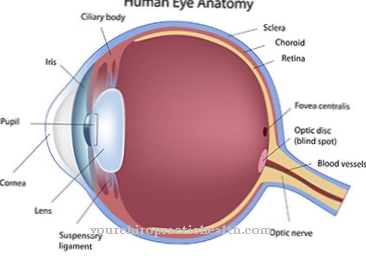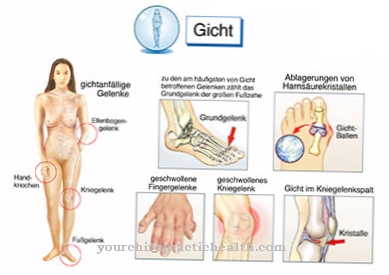The heart has to go through a lot and is at work around the clock. Unfortunately, functional weaknesses of the heart are one of the most common diseases in Germany, with men having a slightly higher risk than women. The likelihood of illness increases with age. A special case of heart failure is that Right heart failure.
What is right heart failure?

© macrovector - stock.adobe.com
Right heart failure is a subtype of heart failure. Heart failure is a malfunction or weakness of the heart. This is no longer able to perform its tasks correctly. So it can no longer pump enough blood into the body to supply all organs with sufficient blood.
The circulation is also attacked and weakened. Right heart failure only affects the right half of the heart or the pumping capacity of the right heart ventricle. The right half of the heart has the task of conveying the oxygen-poor blood to the lungs so that it can be enriched with new oxygen there. But if there is right heart failure, the blood backflows back into the body veins. This increases the venous pressure, causing more water to accumulate in the tissue.
root cause
The most common cause of right heart failure is chronic left heart failure. Because this leads to a backlog of blood in the pulmonary vessels. The result is increased pressure in the lungs.
To compensate for this, the right half of the heart has to use more force to pump the blood to the lungs. Due to the overload, the muscle layer in the right ventricle wall becomes thicker and thicker. In the further course the right half of the heart also fails because the overload becomes too great.
Other causes of right heart failure are diseases of the lungs such as pulmonary hypertension, i.e. an abnormal increase in blood pressure in the lungs. Also a heart valve defect, e.g. can manifest itself in decreased blood flow from the right ventricle, is a possible cause.
Symptoms, ailments & signs
In right heart failure, blood backlog occurs in front of the right heart. This back pressure causes edema in the body, which occurs primarily on the lower legs and ankles. Initially, this edema can be observed, especially at night, when the heart is relieved. Chronic right heart failure can also lead to urination at night (nocturia).
In some cases there is an accumulation of fluid in the abdominal cavity (ascites), which can lead to breathing restrictions. A jugular vein congestion can also be symptomatic of right heart failure, recognizable by overcrowding of the jugular veins. The backlog of the blood can lead to the disruption of individual organ and body functions.
The liver, kidneys, spleen or gastrointestinal tract are affected, recognizable by constipation, loss of appetite, food intolerance. In most cases, right heart failure is preceded by chronic respiratory disease or a pulmonary embolism, i.e. the occlusion of one or more pulmonary arteries, which also shows symptoms such as breathing difficulties, shortness of breath, shortness of breath and blue discoloration of the skin.
Also symptomatic of chronic right heart failure are fatigue and decreased performance. Acute right heart failure leads to circulatory shock, shortness of breath, shortness of breath (dyspnea), increased pulse (tachicardia) and cyanosis, a blue coloration of the skin.
Diagnosis & course
An echocardiography and a chest x-ray are usually performed to diagnose right heart failure. Echocardiography uses ultrasound to visualize the heart. By analyzing both the x-ray and ultrasound images, a cardiologist can quickly identify right heart failure from the magnification of the right half of the heart.
The course of the disease in right heart failure is insidious, as the heart manages to compensate for malfunctions for a relatively long time and symptoms are only noticeable relatively late. The first noticeable symptoms are declining physical performance, e.g. when exercising, as well as frequent fatigue and listlessness.
In the further course, there may be increased shortness of breath. The formation of edema can also cause legs and feet to swell. In the worst case, the heart can refuse to work altogether and a heart attack can occur.
Complications
Right heart failure can have several serious effects. If it develops into acute decompensated heart failure, there is even a risk of life-threatening consequences. The typical symptoms of right heart failure include edema (water retention), which primarily affects the lower legs and the back of the foot. They are usually associated with weight gain.
During the night, the accumulations of water from the body are broken down. Because of this, the patient has to interrupt his night's sleep several times to go to the bathroom, which in turn leads to insomnia. If the blood also accumulates in organs such as the spleen and liver, they grow in size. Sometimes painful pressure develops on the abdomen and tissue fluid forms at this point, which doctors call ascites (ascites).
Right heart failure can also cause various complications that make the heart condition worse. Among other things, this affects the respiratory system, in which pulmonary edema forms or congestive bronchitis occurs, which is noticeable in a permanent cough.
Another possible effect of heart failure is the marked decrease in weight that occurs with a chronic form. Those affected often suffer from underweight. Sudden cardiac death is considered to be the most serious complication of right heart failure. The risk increases with the severity of the heart failure. Other sequelae include cardiac arrhythmias, thyroid disorders, anemia, sleep apnea, and pneumonia.
When should you go to the doctor?
Right heart failure must definitely be examined and treated by a doctor. In the worst case, it can lead to the death of the person affected or reduce the life expectancy of the patient very significantly. The further course depends on when the right heart failure is recognized and treated. The earlier the diagnosis and treatment are initiated, the higher the probability of a positive course of the disease. The doctor should be consulted if the person concerned suffers from frequent urination at night.
Restrictions and discomfort in breathing can also indicate right heart failure and should always be examined by a doctor. Patients often suffer from severe fatigue or various digestive complaints. If these symptoms persist and do not go away by themselves, a medical examination is definitely necessary. Right heart failure can be diagnosed by a cardiologist. In some cases, however, surgery is necessary for treatment. The right heart failure may also limit the life expectancy of the person affected.
Treatment & Therapy
The therapy for right heart failure depends primarily on the severity of the disease. At the first signs of right heart failure, it may be sufficient to adapt the living conditions to the disease.
Smoking and drinking should then be restricted or completely stopped, a normal body weight should be aimed for and stress avoided. More advanced stages of heart failure can be treated with medication. These are intended to prevent possible complications and combat the symptoms of the disease. Diuretics, for example, have a diuretic effect and thus relieve the heart and the vessels in which water is stored.
In addition,]] beta blockers]], which prevent cardiac arrhythmias, and ACE inhibitors, which widen the blood vessels and thus relieve the heart, are often used. In more serious cases, however, the implantation of a pacemaker or an implantable defibrillator is necessary. These can react to or prevent severe cardiac arrhythmias.
If, despite all these methods, the heart failure continues to worsen, in some cases only a heart transplant can help. Either a donor heart or an artificial heart is used for the affected person. However, since such a transplant entails extremely high risks, such as a rejection reaction on the part of the body, it is only considered in an absolute emergency.
prevention
The best way to prevent right heart failure is to live a healthy and conscious lifestyle. Refraining from nicotine and moderate consumption of alcohol promote heart health, as does a balanced, low-salt diet. A lot of exercise in the fresh air, sport and avoiding too much stress in everyday life and at work can also prevent right heart failure.
Even if heart failure is nowadays very treatable thanks to improved medical options and the quality of life of those affected has risen sharply, it is still one of the most common types of death and should therefore not be underestimated. As they develop slowly, older people in particular should have a regular check-up carried out by a cardiologist.
Aftercare
In the case of right heart failure, symptomatic follow-up takes place in order to reduce the risk as far as possible. Drug treatment of the cause is appropriate. If this is hypertension, antihypertensive drugs are prescribed. Drugs are also used to strengthen the heart's pumping capacity and diuretics to reduce the stress on the heart.
With advanced right heart failure, the insertion of a pacemaker with an integrated defibrillator or a biventricular pacemaker is necessary. These help to compensate for the weak heart and avoid cardiac arrhythmias. If the heart is severely damaged, a heart transplant or bypass may be necessary.
A healthy lifestyle should be followed after the illness. Light physical activity and a healthy diet are important here. Other approaches should include giving up nicotine and alcohol, and avoiding obesity. Excessive fluid intake should be avoided and the correct amount should be discussed with the doctor.
Check-ups at regular intervals by a specialist are important. These focus on checking the heart failure and adjusting medication if necessary. Vaccinations against influenza and pneumococci should also be carried out as a precaution. The prognosis for right heart failure depends on the phase of the failure. It is important to adhere to the prescribed therapy in order to avoid complications or worsening. Heart failure leads to death in many cases.
You can do that yourself
The treatment for right heart failure depends on the severity of the disease. Especially in mild cases, the mostly older patients can do a lot to prevent a chronic course with the dreaded complications such as cardiac arrhythmia, pneumonia, sleep apnea or cardiac death.
Anything that burdens the heart unnecessarily is taboo: this includes nicotine and alcohol, but also being overweight. If you are overweight, it is therefore advisable to lose weight. It makes sense here to change your diet slowly, because a rigorous diet also puts a strain on the heart. In addition, studies have shown that diet changes, in contrast to crash diets, show long-term success. Since patients with right heart failure tend to retain water, the diet should be as low in salt as possible.
Even if those affected are no longer so physically resilient, they can still exercise regularly in the fresh air. Walking, walking or even hiking and cycling are sensible sporting activities.
Affected patients should avoid stress, as it also damages the heart. There are several ways you can reduce stress and develop a more optimistic worldview. This can be done through psychotherapy, but also through gentle sports such as Reiki and Yoga, through meditations and breathing exercises or progressive muscle relaxation according to Jacobson. Regular rest and sleeping times also promote relaxation.






.jpg)




















